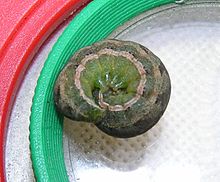Message corridor owl
| Message corridor owl | ||||||||||||
|---|---|---|---|---|---|---|---|---|---|---|---|---|

Message corridor owl |
||||||||||||
| Systematics | ||||||||||||
|
||||||||||||
| Scientific name | ||||||||||||
| Anarta (Calocestra) trifolii | ||||||||||||
| ( Hufnagel , 1776) |
The Meldenflureule ( Anarta (Calocestra) trifolii ), also Kleefeldeule or Clover owl called, is a butterfly ( moth ) from the family of cutworms (Noctuidae).
features
The moths have about 15 to 18 millimeters long forewings. The color of the forewings is quite variable, it ranges from light brown, greenish-brown, gray-brown to blackish. The wetter the habitat , the darker on average the population. In southern Europe and North Africa in a predominantly dry climate, the front wings of the moths are predominantly light brown or light reddish brown in color. The ring flaw is light, the kidney flaw is light above and dark below. The transverse lines are each drawn twice. The wavy line is jagged in the middle with indistinct arrow spots within the line; the serration looks like a W. The hind wings are whitish with a gray border.
The egg is spherical with a flattened base. It is yellowish in color with red-brown spots in the middle zone and a red-brown band. The surface is covered with strong longitudinal ribs.
The caterpillar is greenish or brownish in color with fine black spots. The segment incisions are yellowish in color. The back line is relatively thin and is framed by vertical lines. In the green variant, the side lines are lined with yellowish and white. In the brown variant, there are several fine white lines on the back and black, slightly diagonal lines on each segment. The relatively small head is light brown or greenish in color.
The pupa is yellow-brown with a thorn- and bristle-free, poorly developed cremaster .
- Similar species
Geographical distribution and habitat
The species is distributed almost in the entire Palearctic and Nearctic (with the exception of the northernmost areas). It is said to also occur in Chile , where it was presumably anthropogenic. It lives in almost all open types of habitats, including very dry habitats, e.g. Sometimes even with halophilic vegetation. In the Alps it occurs up to 1600 m above sea level.
Way of life
The reporting corridor owl forms two overlapping generations in Central Europe, whose moths fly from late April to June and June to September. Several generations are formed in climatically more favorable regions. The moths are nocturnal, come to the light and can be baited with sugar. They suck nectar. The eggs are laid or attached to the underside of the leaves of the forage plant in flat clusters of up to 100 pieces. The caterpillars can be found from late June to late autumn. They live individually on dock species ( Rumex ), report species ( Atriplex ), goose feet ( Chenopodium ), nettles ( Urtica ), lettuce ( Lactuca ), Artemisia and many other herbaceous plants . They eat at night. Pupation takes place in a cave in the earth, the pupa overwinters and can remain for a year.
swell
literature
- Hermann Hacker, László Ronkay, Márton Hreblay: Hadeninae I . In: Michael Fibiger, David Agassiz, Martin Honey (Eds.): Noctuidae Europaeae . tape 4 . Entomological Press, Sorø 2002, ISBN 87-89430-07-7 (English).
- Günter Ebert (Ed.): The butterflies of Baden-Württemberg . 1st edition. tape 7 . Moth V Noctuidae 3rd part. Ulmer, Stuttgart (Hohenheim) 1998, ISBN 3-8001-3500-0 .
Individual evidence
- ^ A b Walter Forster , Theodor A. Wohlfahrt : The butterflies of Central Europe. Volume 4: Owls. (Noctuidae). Franckh'sche Verlagshandlung, Stuttgart 1971, ISBN 3-440-03752-5 .
- ↑ Hacker (2002: p. 32/3).
